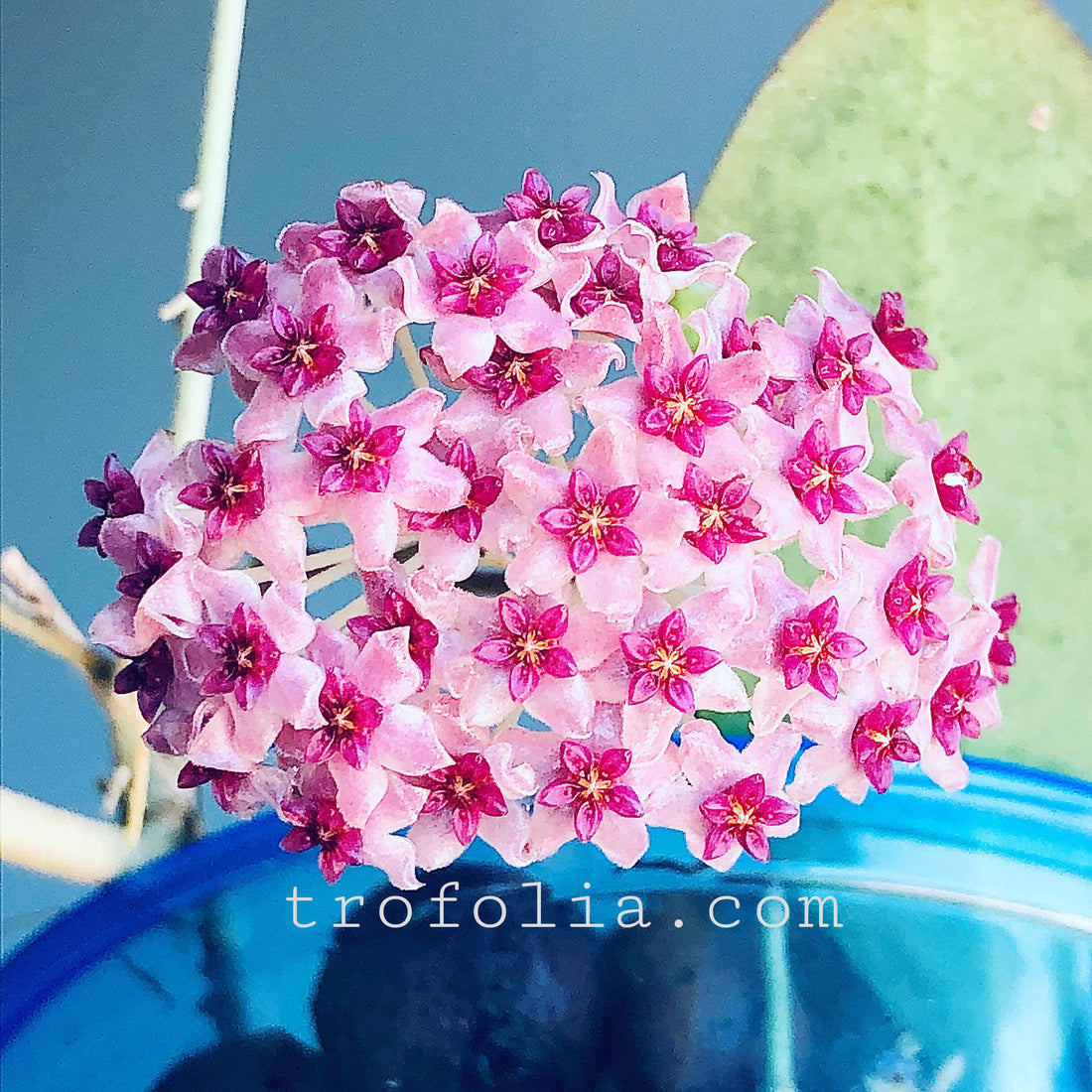
How to Encourage Your Hoya to Bloom
Share
Hoya, commonly known as waxplant, is a genus of hundreds of species. With such a wide variety to choose from they are a treasure trove for plant collectors.
The majority are vining, some are hanging or creeping and a minority grow as a shrub. There is a great variance in leaf shape, size, colour and texture. Their flowers, also known as inflorescences or wax flowers, are equally varied in appearance. They develop from a peduncle that grows off the vine. Most Hoyas keep their peduncles after the flowers expire and a spur remains. From the tip of the spur future flowers will form. Some Hoyas have large, singular flowers but most produce clusters of flowers grouped in umbels, meaning each flower springs from a common centre. Waiting for Hoya to flower can be a lesson in patience and it is much to our delight when peduncles begin to form! How can we encourage or speed up this process?
The first key factor is plenty of bright, indirect light. Eastern or Western window exposure are both great. Southern is good too, provided your Hoya is protected from harsh, direct rays by either shading with a sheer curtain or pulling the plant a couple feet back from the window.
Feed your Hoya when it is actively growing. There are two options when it comes to fertilizer: synthetic or organic. Both do the job well and understanding their differences is key.
Synthetic fertilizers are man-made inorganic compounds and the essential, primary macronutrient ratio (N-P-K, for Nitrogen, Phosphorus and Potassium) will be clearly marked on the bottle. Simply put, nitrogen helps the plant grow vigorously, promoting photosynthesis and good colour. Phosphorus encourages both root development and flowering. While Potassium improves overall health, assisting uptake of other nutrients and boosting resilience against pathogens.
Since synthetic fertilizers have consistent, measurable nutrient ratios we can use them to our advantage to encourage the plant to focus on certain types of growth. To promote flowering, look for a fertilizer with an emphasis on the phosphorous (indicated by a slightly higher middle number in the ratio). Once your Hoya has flowered, go back to a higher nitrogen based food (the first number in the N-P-K ratio) to help it focus on foliage growth.
Organic fertilizers are derived from natural sources (micro organism, vegetable, animal) and are a gentle way to feed your plants. These fertilizers pose less risk of foliage burn. While they usually contain the same nutrients as synthetic fertilizers, the ratios are not consistent and so the N-P-K cannot be recorded. Therefore, they are classified as water conditioners even though they do the same job. Organic fertilizers are simpler to use and, in my experience, give consistent results. For these reasons I opt for my organic nutrients (Marphyl Soil Enhancer) to feed my plants the majority of the time. The results speak for themselves and that’s why I chose to bring Marphyl to our shop!
For the nutrient dosage, you can get as technical or as simple as you wish. An easy way to fertilize is weakly, weekly as long as the plant is actively growing. When it comes to a large plant collection a manageable process is often the best for plants and plant parents alike. Cut the recommended nutrient dose to approximately 1/8 strength for synthetic fertilizers or 1/4 dose for organic and feed your plants this way every time you water. Slowly over time you can slightly increase the dose of nutrients if your plants haven't shown any adverse reactions such as sudden yellowing leaves, leaf drop, shrivelled growth tips, etc.
Alternatively, feed at 1/4 recommended dose for synthetic and 1/2 recommended dose for organic every other watering. Again, you may increase the dose of nutrients slowly over time if no adverse reactions are observed.
While we’re on the subject, it's worth mentioning, plants require secondary macronutrients (calcium, magnesium and sulphur) and micronutrients (iron, manganese, zinc, copper, just to name a few) which are often found in the soil and some fertilizers. If your plants are growing in LECA then you will need to provide these nutrients. Plants in general require mere traces of nutrients consistently during their growing season as that is what they take up in nature. If your plant has fresh potting soil, that potting mix can provide enough nutrients for 4-6 months.
Lastly, be sure to pot Hoyas with a chunky substrate as the majority like to almost fully dry before watering. Some of the smaller Hoyas and thinner-leafed species prefer consistent moisture. If you are providing the right conditions and your Hoya is still not producing peduncles, it may simply be a waiting game. Some species take longer than others. Hoyas generally like to focus on their roots first and once established they'll put their energy into blooming. They also like to have a constant spot to call home, so don’t move yours, especially when it begins to develop peduncles. A change in environment can cause it to drop them. Also keep in mind some Hoyas bloom from the same spurs while other species make new peduncles for each bloom cycle. Never prune a spur and allow your Hoya to grow, as opposed to pruning them frequently, so that peduncles can develop.
Happy growing!
